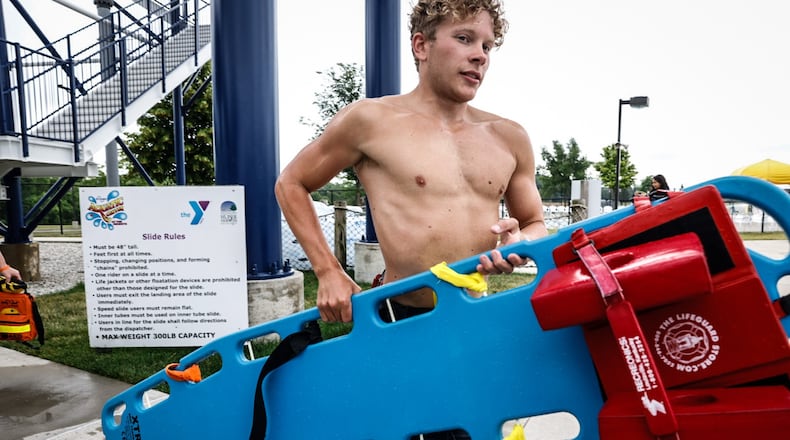Of those cases, 39% were diagnosed with poisoning injuries, most of them from inhaling chemicals, rather than ingesting them. About 28% suffered skin irritation, and 19% were diagnosed with chemical burns. There were no deaths.
“Patients were most frequently injured when inhaling chemical fumes or dust (particularly while opening containers), when pool chemicals were not secured away from children, or when pool chemicals were added to the water just before the patient entered the water,” the study said.
Out of all of the cases, 56% of them were from residential pools. To ensure safety, the CDC recommends that swimmers, and parents of young swimmers should understand “basic water chemistry”, such as rinsing in a shower before getting in the pool to prevent the formation of chlorine and ammonia.
What happened in Troy
The Troy Fire Department was first on the scene at the Dolphin Swim Club in Concord Twp. when it received a 911 call about problems at the pool, followed by the Miami County Emergency Management Agency (EMA).
“We got there and everyone was evacuated and taken out of the pool area to an open field,” said Wade Dexter, Troy assistant fire chief. “A lot of them just had some complaints of coughing, skin irritation, and a little bit of shortness of breath — but no one was super-serious at that point.”
After first responders had assessed the kids’ physical health, they tested the water’s chlorine levels and called in the EMA hazmat team to further handle the situation.
What happened to the pool and the kids
According to Dexter and Bill Frey, the Miami County EMA hazmat director, while the pool workers were back-flushing the system, the chemical dispenser unit was continuing to push out chemicals without flowing water.
When the pumps were turned back on, a large amount of chemicals were dispersed into the water. But they said it didn’t affect the chlorine levels, which is why it likely wasn’t caught before the children entered the pool. The chemical dispenser was old, which led to the malfunction in machinery.
“It was just for lack of a better term, just old-age equipment,” Frey said. “(And) they had already discussed, ‘We need to look into, in a couple of years (replacing) all of this and updating everything.’ They knew it was coming, it just happened before they had expected it.”
Children from ages 8 to 16 went into the pool for their swim team practice that morning.
The majority of the physical issues they suffered were respiratory related, Frey said, along with a few skin irritation issues. He said the main initial complaints were sore throats, coughing, and irritation of the nose and throat area.
Initial reports said 16 children were taken to hospitals for observation, but fire officials said the total was actually 23, as seven were driven to hospitals directly by their family.
Miami County officials said Dolphin Swim Club has since replaced its chemical dispenser and has been approved by Public Health officials to resume business as normal.
Safety: Whose job is it?
Public pools, most of them run by cities, get their chemical levels checked multiple times daily by the pool operators and regularly by the county’s public health department.
“Several times a year we inspect those pools,” said Nate Bednar, director of community services for Miami County Public Health. “We inspect those pools number one, to have all the safety equipment they need — if they’re required to have lifeguards based on their size ... the signage, the water quality issues (and) the flow.
“Adequate flow, adequate filtration, disinfection levels, sanitizing level, the pH levels — all of those things are checked by the owner every day,” Bednar said. “The Health Department does inspections several times throughout the pool season, and then for pools that are opened year-round like an indoor pool we do that all throughout the year.”
Chris Lindeman, executive director of YMCA at the Heights, said their pools get checks every other week from Public Health - Dayton & Montgomery County, in addition to their own daily tests.
“Our pools are checked first thing in the morning with a standard dip test, where we test pH and chlorine levels … to make sure that they are balanced properly and if we need to make any adjustments several hours before we’ve been open, we can make those adjustments,” he said. “Each body of water is then tested every two hours that we are actually open.”
Pool operators are trained in pool chemistry, and head lifeguards learn how to read the chemicals as part of their training. Beyond chemical testing, Lindeman explained that at the end of the pool season they send their pumps back to the manufacturer to be “refurbished and maintained.”
For personal, residential pools it’s important to regularly check your chemical and pH balances as well. Chlorine can be burned away in the sun, and without combating acids, could burn away up to 90% of the available chlorine in your pool, according to Natural Pool Products.
Tips for your family
Warning signs of chemical issues may not always be instantly noticeable at a pool. Experts say to rely on your sight and smell.
“(Pool goers) may see a discoloration in the air, showing the gas itself, and they’ll see and smell an unusual odor,” Frey said. “The best thing is to stay away from it, walk away from it, (and) wait and stay in the fresh air.”
Bednar explained some of the more visual determining factors.
“The one thing that I think is probably most important to look at when you’re in the pool is the clarity of the water,” he said. “For example if you can’t see the bottom, you know there’s probably some sort of issue there with filtration or the chemicals themselves. The other thing is if there’s any color to it like green algae.”
About the Author

